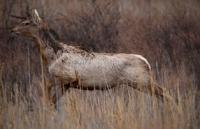Вы здесь
Mammals of Badai-Tugai reserve.




Tours to reserves of Uzbekistan.
"Animals are very nice friends: they don't ask questions or criticize"
George Eliot. Mary Ann Evans.
Sights of reserves of Uzbekistan.
From the order of insectivores, there are eared hedgehogs and piebald shrews here. Of bats - a whiskered bat, a dwarf bat, a two-tone leather, of a hare - a tolai hare. Among rodents, the common lamellar rat, house mouse, comb gerbil, etc.
Of the predators, jackals are common - habitats are rugged tugai, and the badger is an inhabitant of tree and shrub vegetation. In the reserve, you can occasionally come across a jungle cat that lives in empty coastal tugai.
Ungulates "Badai-Tugai" are represented by two species: wild boar and Bukhara deer. Wild boars keep exclusively in tugai, where they feed mainly on cattail and reed rhizomes, and in autumn on sucker fruits. The pride of the reserve is the reaclimatized Bukhara deer.
He once inhabited the basins of the Amu Darya rivers and the lower reaches of the Syr Darya. The population of the Bukhara deer in Uzbekistan was undermined by the predatory extermination of this beast. This prompted the start of deer re-acclimatization in the Badai-Tugai nature reserve.
Nursery in the Badai-Tugai nature reserve. In 1976, an open-air cage was built on an area of 8 hectares, in May three deer (two females and one male) were brought from the "Romit" reserve (Tajikistan) and they were kept in mesh cages.
In December 1979, 9 more reindeer were introduced. The deer took root and gave birth to offspring. Taking into account their obvious overexposure in the enclosures, the deer were released into the tugai forest. Partial release of deer took place at the end of September 1981 (5 deer) in June 1982 (8 females and 11 males).
Already in 1984, the number of Hangul deer reached 30 - 31 individuals. The creation of the Badai-Tugai population of Bukhara deer, listed in the International Red Book of the Union for Conservation of Nature (IUCN) and the Red Book of the Republic of Uzbekistan, should be considered as a great achievement of the reserve.
Currently, the nursery maintains 33 different-aged reindeer together with the 2007 litter (7 newborn young reindeer). Nowadays, the number of reindeer has reached 302 individuals (Accounting 2006). Reindeer began to settle themselves in the neighboring tugai massifs both on the right and on the left banks of the Amu Darya.
In the neighboring Taldyk-tugai, the reserve inspectors saw about 15 - 18 deer, and in the Atau forest on the left bank of the Khorezm region, more than 20 deer. Often, deer also leave for the Kyzylkum desert, becoming the prey of poachers.
Reserve "Badai-Tugai", according to the Karakalpak scientists I.S. Zholdasova, G.A. Assenov, L.P. Povlovskaya et al. (2004), is the keeper of the world's largest population of Bukhara deer and is becoming globally significant.
However, its tugai area is now becoming cramped for the formed herd of deer. Therefore, we consider, first of all, to consider the issue of joining the neighboring Taldyk-tugai and Atau-tugai to the reserve on the left bank of the Amu Darya, where Bukhara deer live.
Considering the importance of tugai ecosystems in stabilizing the ecological situation in Karakalpakstan, all remaining tugai massifs from Badai-Tugai to Bozatau should be protected. What are the further ways of preserving the Bukhara deer in our republic?
So, historically, their habitats were limited to riparian forests growing in narrow strips along the Amu Darya and Syr Darya rivers. In the lower reaches of the Amu Darya and Syr Darya rivers, at present, the most significant tracts of tugai forests are preserved on the islands and in the coastal strips of the lower reaches of the Amu Darya.
According to the Joint UNDP-GEF and the Government of the Republic of Karakalpakstan "Preservation of tugai forests and strengthening the system of protected areas in the Amu Darya delta in Karakalpakstan", more than 170,154.9 hectares of tugai forests grow in the lower reaches of the Amu Darya.
Of these, 13020 hectares of tugai forest are of great value as a natural reserve - the preservation of which is of great importance in solving the problem of resettlement and restoration of the Bukhara deer in the Republic of Uzbekistan.
At present, the area in the "Badai-Tugai" reserve is 6462 hectares, and the number of deer in nature and adjacent territories is more than 302 individuals.
Authority:
https://uzb.ucoz.ru/index/badaj_tugaj/0-178
Photos by
Alexander Petrov.







